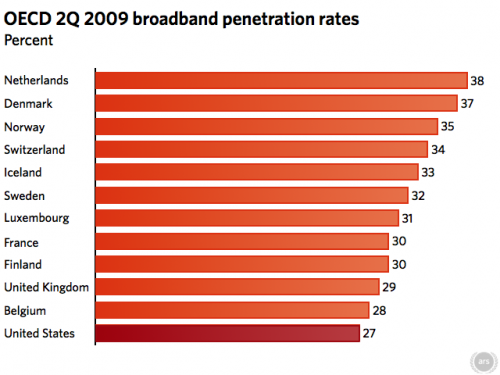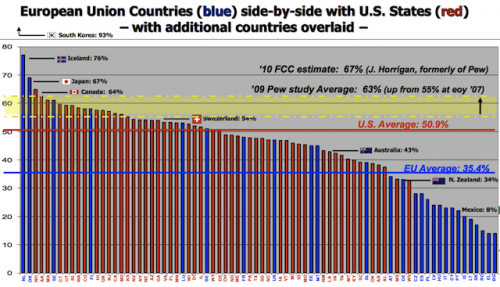
Fact-Checking Verizon's CEO on US Broadband Awesomeness
[Source: ArsTechnica.com, by Nate Anderson, April 16, 2010]
Verizon CEO Ivan Seidenberg sat down last week for a talk at the Council for Foreign Relations and talked about how mind-bendingly awesome the US broadband market is. Seidenberg all but put on a foam finger and started chanting, "We're number one! We're number one!"
All those studies you've read that suggest otherwise? The fact that Hong Kong residents can now get 1Gbps symmetric fiber for US$26, while New York City residents top out at 100Mbps and cost $100? Capping 3Mbps DSL at 5GB/month? All meaningless.
Apparently, we've been focusing on ridiculous measures like speed and features, when what we should really focus on is broadband penetration. And, according to Seidenberg, the US is beating the pants off everyone else when it comes to getting broadband into people's homes.
We decided to fact-check this claim.
As a reminder, here are Seidenberg's words from the interview:
Seidenberg: Anytime government—whether it's the FCC or any agency—decides it knows what the market wants and makes that a static requirement, you always lose. So this FCC decided that speed of the network was the most important issue. So that's all they measured.
So they will say, if you go to Korea or you go to France, you can get a faster Internet connection. Okay? That could be true in some companies—in some countries. The facts are that, in the US, there is greater household penetration of access to the Internet than any country in Europe.
In Japan, where everybody looks at Japan as being so far ahead, they may have faster speeds, but we have higher utilization of people using the Internet. So our view is, whenever you look at these issues, you have to be very careful to look at what the market wants, not what government says is the most important issue.
Let's take wireless, for example. Everybody says the European system was kind of better. Well, that's very interesting. If you look at minutes of use, the average American uses their cell phone four times as much—four times as much—as the average European. If you look at Europe, they publish penetration rates of 150 (percent), 160 (percent), 170 percent meaning that people have more than one phone, two phones, three phones.
You know why? Roaming rates are so high. My guess is you probably have two or three different phones to carry to—to use in different countries because your roaming rates are so high. And you say, yes.
So my point is it's a fallacy to allow a regulatory authority to sit there and decide what's right for the marketplace when it's not even close.
[WSJ executive editor Alan] Murray: So on the measures that matter most to you, where does the United States rank in terms of—
Seidenberg: One. Not even close.
Murray: Number one?
Seidenberg: Yes. Verizon has put more fiber in from Boston to Washington than all the Western European countries combined. All. We have—if you look at smart phones—not us, Apple, Google—they have exploded this market in the US. Ask any European if they're not somewhat envious of the advancements of smartphone technology in the US. So it just seems to me this is just not even close.
Those pesky facts
Does the US has greater household Internet penetration than "any country in Europe"? We dug through the OECD's most recent broadband dataset, from the second quarter of 2009, and looked at penetration rates in Europe and the US. Here they are, in chart form:

OECD broadband penetration rankings
Not only is the US getting beaten by plenty of European countries, we're getting whipped by almost 50 percent in places like the Netherlands, Norway, and Denmark.
We then went back and checked earlier data from the OECD, going all the way back to 2002, and the same basic pattern held. In terms of raw numbers, the US has the most broadband subscribers due to its size, but when it comes to penetration rate, it's just objectively beaten by numerous European countries (South Korea and Canada are also ahead of us).
We then checked data from the United Nations-backed ITU. Its data, most recently from 2008, shows the same story: the US broadband penetration rate is 23.46 percent, while countries like Sweden are at 41.19 percent.
But wait—only a quarter of the US population has broadband at home? Not quite; the measurements we've been citing above all describe the number of broadband subscribers divided by the population. A moment's thought will show that most broadband subscriptions serve multiple people in a household.
This fact could skew the data. If the average household size in the US is higher than that in Europe, it could be that we have a lower percentage of home broadband subscriptions but a higher percentage of actual home broadband users.
So we looked into this, too. Consulting group Gartner actually gathered this data and put out a press release about it in September 2009. When penetration data is sorted by the percentage of households with access, the US comes in... 14th place, with 60 percent of households having home broadband.
South Korea topped the list at 86 percent, but right behind it were the Netherlands, Denmark, and other European countries.
Let's complicate matters
Not to put too fine a point upon it, we're left with the question: is Seidenberg the sort of CEO caricature we love to mock, the leader with marshmallow for brains and a mouth that spews only PR, leaving facts bleeding and bruised in its wake? He was certainly wrong on this particular statement, but the real story is much more complex.
Remember that this was a live interview without notes and without editing. When Seidenberg gave prepared remarks before the interview began, he phrased things differently.
I know this goes against the conventional wisdom that America is way behind in wireless and broadband. The truth is, that belief is more about the past than it is about the present or certainly the future. Asia's cell phone ecosystem developed so fast because the mobile handset—not the PC—has been their primary means for accessing the Internet. Europe's wireline broadband infrastructure spread quickly because of state subsidies and a compact geography, among other things. The US market has developed differently, based on a private investment model and competition among different wired and wireless technologies. The result is that—today—the US market stacks up very well in the global market in terms of:
• Choice: with the vast majority of Americans having access to two or more broadband networks;
• Utilization: with higher broadband penetration and wireless data usage than Europe as a whole; and
• Quality: with the most advanced fiber and fourth-generation wireless data networks being deployed in the world today.
Note two things: first, Seidenberg doesn't make his "we're-number-one-and-it's-not-even-close" claim. Instead, he offers a more nuanced analysis. Second, when it comes to discussing penetration rates, his prepared remarks talk about Europe as a whole rather than saying the US beats "any country in Europe."
This is more helpful, but still not clear. Is Seidenberg saying that the US should compare itself to countries like Montenegro, Moldova, and Belarus when it comes to broadband? A fairer comparison would seem to be Western Europe as a whole, where the US is beaten by numerous countries—yes, even those that are less dense than we are (including Sweden, Finland, Iceland, and Norway).
We checked in with two Verizon executives for clarification. Though unwilling to speak on the record, they did provide more context for Seidenberg's remarks. Verizon's view of the matter is that a proper comparison is not between the US as a whole and a state like Sweden; it's between the US as a whole and the European Union as a whole.
Such a metric raises its own questions. It leaves wealthy, high-broadband countries like Norway and Switzerland out of Europe's measurements, making the continent look worse. It also includes countries like Slovakia and Bulgaria and Latvia and Romania—as beautiful as it is, is Slovakia really a good comparison with the US?
All such metrics have these problems; what you find depends in many ways upon what you measure. Accepting Verizon's comparison, though, Seidenberg was correct: the US as a whole has a higher penetration rate than the EU as a whole. In fact, Verizon has compiled a handy chart to make the point. It breaks the US down into states and compares these against EU countries. Even the lowest US state for broadband penetration (West Virginia) beats countries like the Czech Republic and Slovakia and Poland.

Verizon's preferred way of looking at the data
According to this data, the US' average penetration rate was 50.9 percent in 2008, while the EU rate was 35.4 percent. Both numbers have increased significantly since then.
One could look at this data in many ways. Why is it, for instance, that Iceland and Denmark beat out even the wealthiest, densest states in the US? (Remember, Iceland is less dense than the US.) Why is penetration in Slovenia better than five US states? Certainly, one of the richest countries on earth could do a bit better on these metrics.
On the other hand, the US has done a solid job of getting basic broadband access to most citizens, beating out the EU in broadband uptake.
Verizon also likes to point out how much fiber it has laid relative to all of Western Europe, and it's true—FiOS was an impressive, $20 billion rollout that showed future vision as opposed to fixation on short-term returns. That's great if you can get it—and most Americans can't. Many New York City residents (such as our own John Timmer) can't, and citizens of Boston can forget about it. And those are solidly within Verizon territory—FiOS isn't passing any more homes, and the rest of the country had better like paying for cable Internet if they want high speeds, because the phone companies have shown little interest in running the necessary fiber to the home.
In conclusion: though Seidenberg's quoted comments in the interview were in fact incorrect, he was getting at a real point. In doing so, he reminded us how conclusions depend on what's being measured—Verizon's no less than the FCC's.


